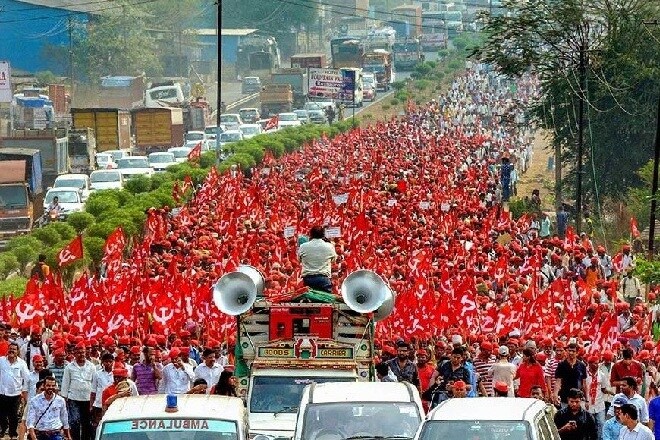The farmers’ protest in Maharashtra on Sunday evening reached Mumbai with the demand of “unconditional” loan waiver for the crop loss due to unseasonal rain. Over 35,000 farmers in the state have marched 180 kms for the past six days agitating against the government’s decision to allow loan waiver but it was “partial and conditional”.
Even as the Devendra Fadnavis government last June announced the “biggest farm loan waiver” of Rs 34,022 crore, the farmers are protesting a proper implementation of the scheme. Left-affiliated All India Kisan Sabha (AIKS), which is spearheading the protest, said that farmers and tribals are also protesting against land acquisition for high-speed railway and super-highways projects.
The farmers also want the implementation of the Swaminathan Commission recommendations and Forest Rights Act and an increase in pension schemes for poor peasants and farm workers.
Maharashtra Chief Minister Devendra Fadnavis said that the government was “sensitive and positive” towards the demands of farmers and tribals. A similar protest in the state was witnesses last year following which the state government had announced the loan waiver.
Last year, a series of protests emerged from different states — Tamil Nadu, Punjab, Uttar Pradesh and Maharashtra, following which four states announced partial loan waivers. Finance Minister Arun Jaitley last June ruled out any farm loan waiver from the central government with an aim to stick to fiscal deficit target.
The Narendra Modi in the fiscal year 2017-2018 missed its fiscal deficit target by 0.3 percentage points and for the next fiscal year has kept a fiscal deficit target of 3.3% of the GDP as against 3% planned earlier.
Meanwhile, the Maharashtra government, while presenting this year’s state Budget, said that the Rs 34,000-crore farm loan waiver was one of the reasons behind Rs 15,000 crore revenue deficit. Economic analysts are also of the opinion that it is important for governments to have a better income compensation scheme instead of loan waivers.
“It is important to at least move ahead with an income compensation scheme rather than perpetually promote a loan waiver culture for the farmers,” said a recent SBI’s research report. Some analysts have also argued that crop insurance is an answer for crop failures, not loan waivers.
Reserve Bank of India governor Urjit Patel too dismissed farm loan waiver, calling it a quick fix. “In the absence of coordinated and sustained efforts to put in place elements of a virtuous cycle of uplift of farmers’ income, loan waivers have periodically emerged as a quick fix to ease their distress,” an RBI statement quoting Urjit Patel said.
According to the RBI, the bad loans in the agricultural sector rose to over 23% from Rs 48,800 crore in 2016 to Rs 60,200 crore in 2017, while short-term crop loan lent stood at Rs 6,22,685 crore, surpassing the target of Rs 6,15,000 crore.
A research conducted by IIT Kanpur pointed out that households in expectation of loan waiver make unproductive expenditures. “Households that have actually received the waiver, those that are eligible and those with knowledge of waiver, exhibit an increased consumption and social spending,” the research report said.
The Economic Survey report 2018 flagged climate change as the biggest challenge for the agriculture sector in the country, saying that it continues to be vulnerable to the vagaries of weather. The report suggested government to address the need for “dramatic” improvement in irrigation, use of new technologies and better targeting of power and fertiliser subsidies.
Even as the Narendra Modi government is aiming to increase Minimum Support Price (MSP) for farmers and doubling their income by 2022, massive farmers’ protests indicate slower or unsatisfactory implementation on the ground.

